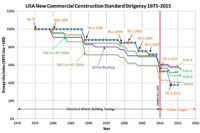
|
| Robert Wilkins |
It is said that progress that is not sustainable is not progress, and neither is technology that is under-deployed. One of the often-cited barriers against the deployment of proven, energy-efficient solutions is a lack of funding or funding mechanisms. But there are, in fact, funding vehicles that have proven very successful — if we make them a priority and a key component of progress.
Market-Driven Approach
At the core, financing energy efficiency should start with a market-driven approach. Markets have proven to be very powerful drivers of energy efficiency in some areas of the world. Countries as different as Denmark and Japan have in common a high price of energy, and, as a result, high-efficiency solutions have been broadly deployed and accepted in both countries. In Japan, for example, virtually 100 percent of home air conditioning systems are variable speed, which cuts energy use by about 30 percent compared to fixed-speed systems.
By contrast, in the U.S., where energy is comparatively cheap (from a global perspective), only around 1 percent of residential air conditioning systems are variable speed. More broadly, countries where energy is subsidized see weaker interest in conservation and the means to achieving it. Waste is not recognized as waste if it does not entail a cost.
Variations such as this give a clear advantage to a market-based approach to driving energy efficiency.
Energy Savings Performance Contracts
At many levels, government seeks a leadership role on energy efficiency — to provide leadership by example, to spur product development, to reap the cost savings, and to gain other advantages that can flow from waste reduction. However, government also lacks capital.
It is no surprise, then, that government has been a leader in utilizing energy savings performance contracts (ESPCs), a market-based approach to financing energy-efficiency projects that has been around for several decades.
In brief, ESPCs allow investors to buy energy savings projects and earn a stream of revenue from the energy savings. Several building equipment companies offer such contracts. These contracts work because, lacking capital, government agencies are often required to buy equipment from the lowest bidder, and by selling the savings revenue stream separately or holding it themselves, such equipment providers can bring the first cost of advanced equipment down to levels that are competitive with less sophisticated technology.
Danfoss and other companies are working hard to encourage the expanded use of ESPCs by the federal government — not because we can take advantage of them directly, but because our customers can. The expanded use of these contracts would be mutually beneficial throughout the industry, as they also would help stimulate high-efficiency equipment business.
Utility Incentives
In the U.S. and Canada combined, utilities provide about $7.5 billion annually in incentives for energy savings. Most are in the form of rebates for purchasing higher-efficiency products, so it is understandable that these incentives are favored by the equipment industry. Nevertheless, utility incentives also can be challenging.
Rebates vary in design from state to state, utility to utility, and among state regulatory agencies. Some are structured to incentivize annual energy savings or energy efficiency, while others reward peak-load reduction. There also are sizeable incentives for demand response or load control programs to control peak demand.
Obviously, such differences influence the role utility incentives play in financing energy efficiency. And because utility regulation is inherently bureaucratic, there are many economic inefficiencies and zones of arbitrariness.
Each program and incentive, for example, must first be calculated by a formula to be cost-effective and then verified by the state public utility commission — a complex business. And rules vary by state. Some states base the payments for energy incentives, while others empower the utility to add charges to the utility rate. Programs have to be cost-effective to both the participating customer and to the utilities’ general body of rate payers — a sometimes vague and varied target.
Other issues exist, as well. For example, state regulators frequently sidestep incentivizing the replacement of old and inefficient equipment, reasoning that it will soon be replaced out of necessity anyway. Incentives may, therefore, be calculated on energy savings above the level of the federal minimum efficiency standard, giving little encouragement to replace old, inefficient equipment with modern equipment that uses perhaps half the energy of its out-of-date equivalent.
OBF and PACE Programs
Still, utility incentives can be powerful and effective tools. Many utilities offer on-bill financing (OBF), which allows utility customers to invest in energy-efficiency upgrades or improvements and repay the cost through charges added to their utility bills. The upside to OBF is that it reduces or eliminates upfront costs and aligns timing to costs and benefits to generate positive cash flow. OBF programs can also complement rebates, grants, or tax incentives for energy-efficient products to further reduce upfront costs.
Similar to OBF, property assessed clean energy (PACE) programs are financing mechanisms that support energy-efficiency upgrades, such as HVAC, motors, and lighting, by providing upfront capital that is repaid through a special assessment on property taxes.
PACE funding is provided or arranged by a local government for 100 percent of a project’s costs. It allows owners to benefit immediately from the energy upgrade and is repaid with an assessment over a term of up to 20 years. Unlike other financing vehicles, PACE funds are tied to the property itself, not the property owner, and can be transferred to the new owner or shared by tenants.
PACE programs are locally based, and energy service contractors provide the initial energy savings assessment. The programs are essentially simple mechanisms that are easy to tap into and provide a direct and immediate economic impact. They may well provide a model of how to get the benefits from, and avoid the downsides of, utility incentives.
Removing Barriers
Providing and encouraging effective avenues of finance are critical to expanding the impact of energy-efficient technology in buildings. Perhaps no less important, however, is the removal of barriers to effective finance.
In the case of the built environment, two specific financing barriers stand out prominently.
The first is split incentives, which occur when the owner of the building does not pay for the energy consumed and is, therefore, not incentivized to make energy-efficiency upgrades a priority. The second barrier is related to tax laws: HVAC equipment is depreciated over a 39-year period, which far exceeds the life of the equipment. These depreciation rules incentivize retaining antiquated equipment, and, in effect, amount to a subsidy for energy inefficiency.
Such barriers as split incentives and misdirected depreciation rules are not in place without reason. Each has its own rationale. But, as energy efficiency moves up the list of public priorities, those reasons need to be reassessed to make energy efficiency and highly efficient, sophisticated technology financially feasible.
Finance drives the economy. The energetic flow of financial resources to energy efficiency is vital to making efficiency work in the building marketplace. A fresh look at the place of efficiency among our national priorities and rethinking existing policies that are, in effect, barriers to enhanced building efficiency, should be a principal goal of public- and private-sector leaders who are committed to sustainable progress.
Publication date: 6/23/2014
Want more HVAC industry news and information? Join The NEWS on Facebook, Twitter, and LinkedIn today!










